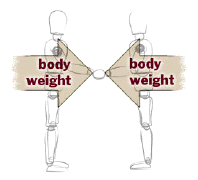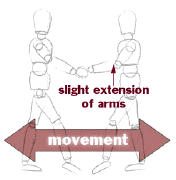Leading and Following in Open Positions
Leading Oppositional Movements
Oppositional movement occurs when two partners move in opposite directions, such as they do during a Rock Step in East Coast Swing or Jive.
 |
 |
Step 1: Extablish a weight connection. |
Step 2: Gently push away by icreasing tone in arms, them move in opposite directions. |
The technique for leading of oppositional movement is slightly different than that of leading basic directional movement, where partners move in the same direction. In order to lead oppositional movement, a slight and momentary push or pull "impulse" from the arms and hands is necessary. Otherwise, the follower would move in the same direction as the leader. Still, the pushing or pulling impulse of the arms and hands is not a substitute for the weight connection altogether. The weight connection must still happen before the impulse.
Use of Arms
When used properly, the arms and hands can aid in leading oppositional movement. But what exactly is "proper" use of arms and hands? What makes the use of arms an aid, as opposed to a distraction? Here are a few hints:
- The weight connection must still be established, first.
- The impulse should be a subtle action, not a strong yank or shove.
- Instead of pushing the connection away from your body, push your body away from
the connection. This is important enough to repeat, so here goes...
Instead of pushing the connection away from your body, push your body away from the connection.
This may seem logical, but it's surprising how many followers don't quite get it right. The most common mistake is to react to the feeling of push by taking a back step, or to react to the feeling of pull by taking a forward step. Remember, the leader's invitation to push or pull is not an indication of where to move. It is merely an attempt to establish a weight connection toward or away from each other.
So when you feel the leader's weight shifting toward you, you should shift your weight towards him. Don't actually take a step. Before you can take a step, the following conditions must be met:
- You've both shifted towards or away from each other, and you can clearly feel
each other's body weight.
- Through this weight connection, you actually feel him take a step.
To take a step before you establish the weight connection is to second-guess the leader's intentions, which you now know is an ineffective and error-prone method.
Think of the connection as a fixed point in space. In order to step back, push your body away from the connection. Leaders -- this applies to you, too! You do not need to literally push your partner backwards. The follower will respond to the impulse resulting when you push your own weight backwards.


